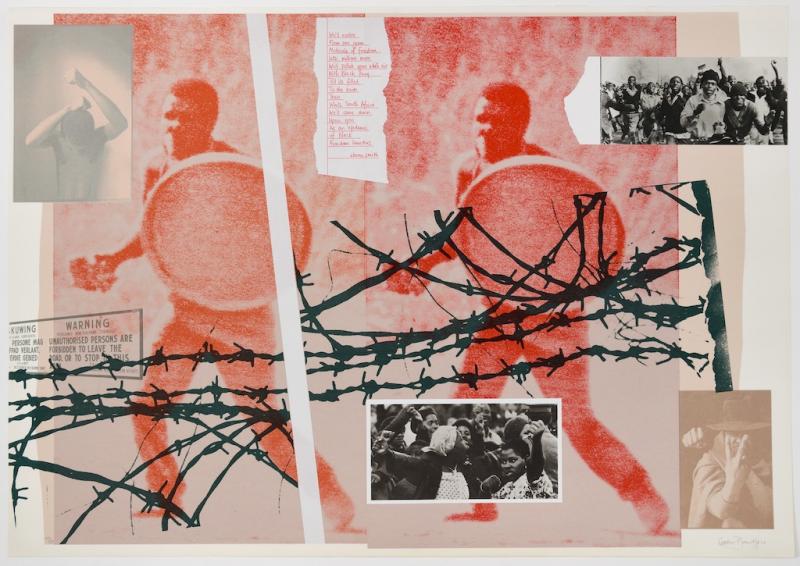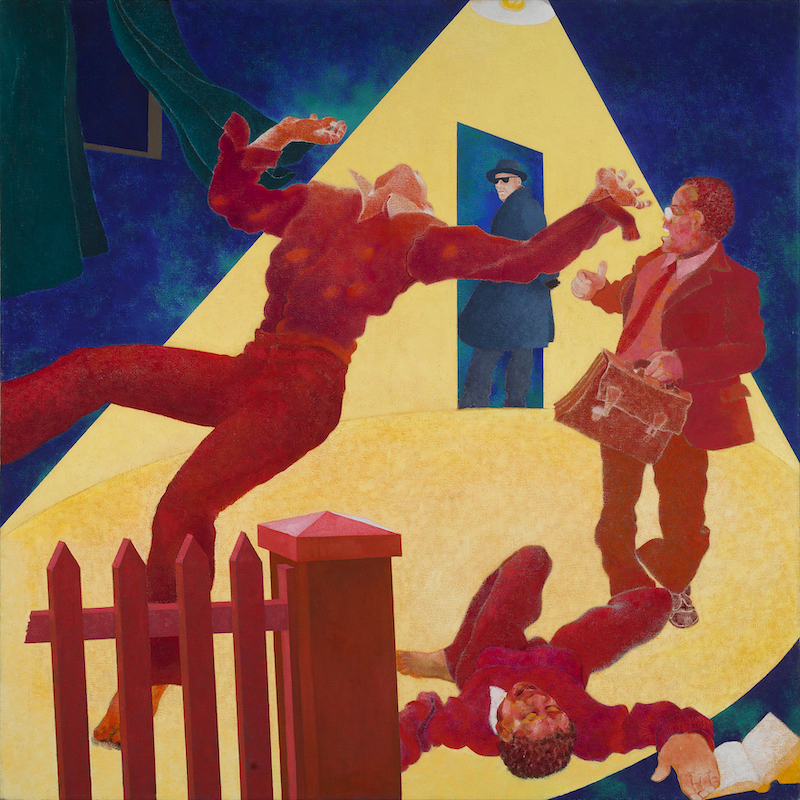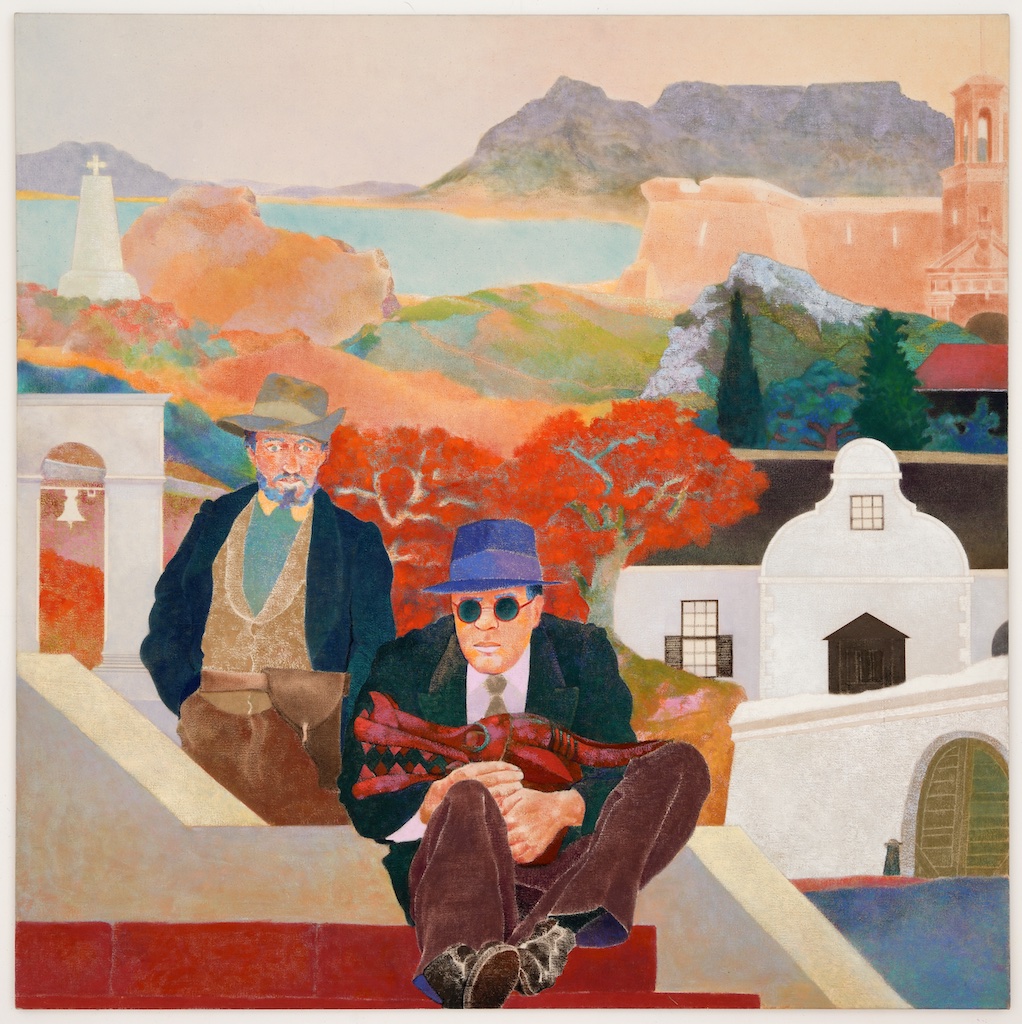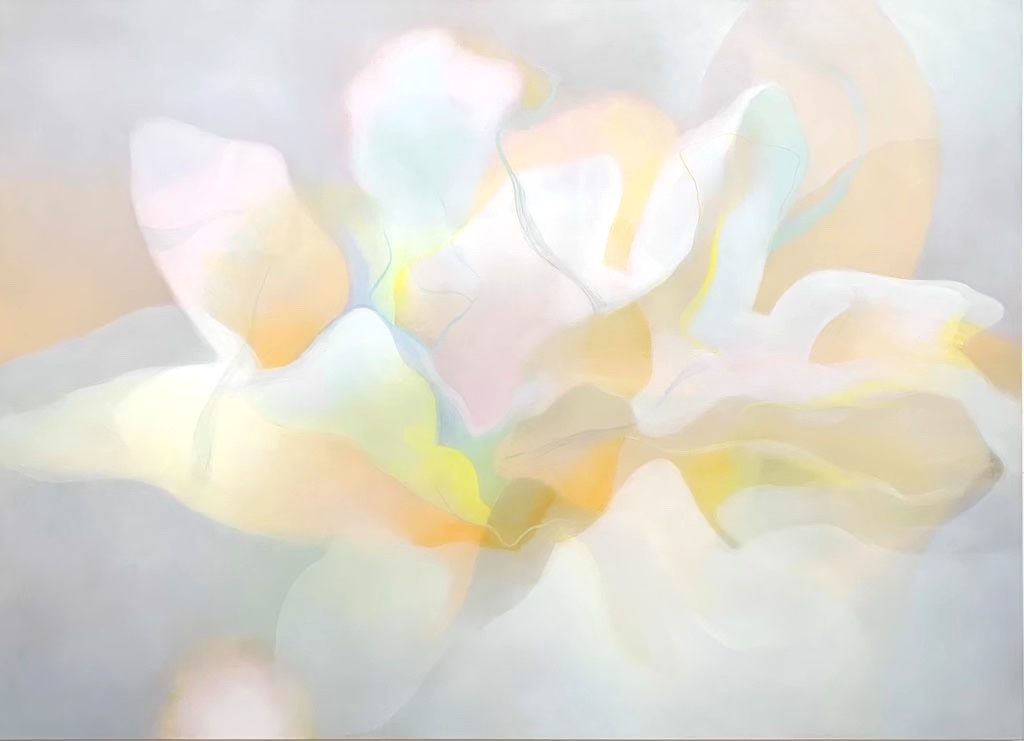Gavin Jantjes: To Be Free, Whitechapel Gallery review - a sweet and sour response to horrific circumstances | reviews, news & interviews
Gavin Jantjes: To Be Free, Whitechapel Gallery review - a sweet and sour response to horrific circumstances
Gavin Jantjes: To Be Free, Whitechapel Gallery review - a sweet and sour response to horrific circumstances
Seething anger is cradled within beautiful images

Born in Cape Town in 1948, Gavin Jantjes grew up under apartheid. He openly criticised the regime in his work and, forced into exile, was granted political asylum in Germany in 1973.
Nearly 10 years later he moved to England and his Whitechapel retrospective begins with work from those early years of exile. School Days and Nights, 1978 (pictured below right) was painted in response to the Soweto uprising, when black schoolchildren held a rally in protest against the imposition of the Afrikaans language in schools. The police opened fire on the children sparking an uprising that lasted eight months and saw the deaths of some 700 students.
In Jantjes’ painting, it’s night time. A spotlight bathes the scene in harsh yellow light; silhouetted against the glare are two boys, one lying motionless, the other caught mid-fall, riddled with bullets. Behind them is a man with a briefcase, probably their teacher, running to escape the gunfire. Looking on from a doorway is a white man who resembles Hendrik Verwoerd, the architect of apartheid. He may not be wielding a gun, yet the deaths are his responsibility.
 Despite being quite small, the painting packs a mighty punch. The drama of the event is underscored by the violent contrast of blazing red against searing yellow, dark green and midnight blue. It’s as though the massacre has burned itself into the artist’s retina.
Despite being quite small, the painting packs a mighty punch. The drama of the event is underscored by the violent contrast of blazing red against searing yellow, dark green and midnight blue. It’s as though the massacre has burned itself into the artist’s retina.
Homesickness, a Blindman’s Paradise 1982 (pictured below left) hangs beside it. Painted in the hazy colours of nostalgia, it portrays the artist's home town, which he inevitably misses. Dominating a landscape of limpid greens, soft oranges and pale turquoise is the silhouette of Table Mountain. The acacia trees are in full bloom and their fragrance seems to fill the air.
Two somewhat sinister white men, a collector cradling an African mask and an Afrikaner with a rifle tucked in his holster, are surrounded by Cape Town landmarks – the fort and prison, a slave bell and the cross commemorating the arrival of Portuguese explorer, Vasco de Gama in 1497.
This apparently tranquil scene turns out to be a riff on colonial rule. The men symbolise the seizure of land by Dutch settlers and the shipment of African artefacts to the West. And the buildings indicate the various means used by the colonisers to subjugate the indigenous population. Ironically, the place the artist recalls with such tenderness has been indelibly shaped by the oppressors.
Jantjes is best known for silkscreen prints which, like the early paintings, are bitter sweet commentaries on the horrors of apartheid. Photographs, drawings, news clips and snippets of text are juxtaposed in complex arrangements that are as beautiful as they are horrific. The duality, he explains, is the result of “a need to cry rage; yet simultaneously I wanted a voice that could sing a visual song for and about black people.”
 Freedom Hunters 1977 (main picture) pays tribute to the bravery of Soweto youth while Notes From Slavery features the diagram of a slave ship beneath a picture of a man in a slave collar and a handbill advertising negroes for sale.
Freedom Hunters 1977 (main picture) pays tribute to the bravery of Soweto youth while Notes From Slavery features the diagram of a slave ship beneath a picture of a man in a slave collar and a handbill advertising negroes for sale.
The tile of his best known series A South African Colouring Book, 1974-5 makes ironic reference to the categories used, under apartheid, to define people’s racial identity. The artist was labelled "Cape Coloured”, for instance. Eleven prints elucidate aspects of the regime’s brutality. On 21 March1960, the breaking news was “Massacre of Africans at Sharpeville”. Police had opened fire on a crowd protesting against the imposition of passbooks. Beneath photos of the massacre, the caption reads “Colour these people dead”.
A black woman scrubs the floor of a public lavatory beneath a sign reading “whites only”. Repeated six times, the image encapsulates the tedium of demeaning labour. Pinned to the sheet are the hand written thoughts of South African president John Vorster. “The fact that they work for us can never… entitle them to claim political rights,” it says. “Colour this labour cheap” reads the caption.
Jantjes started lobbying for greater recognition of black and Asian artists and began curating exhibitions of their work. Gradually the curating took over until, in 1998, he became director of the Henie Onstad Arts Centre near Olso before moving to Norway’s National Museum of Art, Architecture and Design. On view in Gallery 4 are catalogues, photographs and videos of the exhibitions he organised as well as those he took part in, which provide an overview of his impressive contribution as both an artist and curator.
But after 25 years he’d had enough of curating and, in 2017, returned to the studio. And what a surprise awaits you! The new paintings are physically and emotionally expansive. Gone is the political content, but the beauty is still there. These days it’s safe for him to return to South Africa, and one of his favourite haunts has become Cape Town’s National Botanical Gardens, where every species of African plant is grown. Inspired by the lush vegetation, the recent paintings engulf you in pure sensation. Swathes of translucent colour waft across large canvases like coloured smoke hanging in the air. And elsewhere, delicate colours that are as luscious as Italian ice cream – pink, apricot, lilac, yellow, pistachio and peach – conjure the heady sensuality of perfumed tropical nights.
Inspired by the lush vegetation, the recent paintings engulf you in pure sensation. Swathes of translucent colour waft across large canvases like coloured smoke hanging in the air. And elsewhere, delicate colours that are as luscious as Italian ice cream – pink, apricot, lilac, yellow, pistachio and peach – conjure the heady sensuality of perfumed tropical nights.
It’s as though, purged of negative associations, the landscape portrayed so lovingly in Homesickness… has finally been restored to him. At last, he is able to let go of the rage and relish the beauty of his homeland.
- Gavin Jantjes: To Be Free at the Whitechapel Gallery to 1 September
- More visual arts reviews on theartsdesk
rating
Explore topics
Share this article
The future of Arts Journalism
You can stop theartsdesk.com closing!
We urgently need financing to survive. Our fundraising drive has thus far raised £49,000 but we need to reach £100,000 or we will be forced to close. Please contribute here: https://gofund.me/c3f6033d
And if you can forward this information to anyone who might assist, we’d be grateful.

Subscribe to theartsdesk.com
Thank you for continuing to read our work on theartsdesk.com. For unlimited access to every article in its entirety, including our archive of more than 15,000 pieces, we're asking for £5 per month or £40 per year. We feel it's a very good deal, and hope you do too.
To take a subscription now simply click here.
And if you're looking for that extra gift for a friend or family member, why not treat them to a theartsdesk.com gift subscription?
more Visual arts
 'We are bowled over!' Thank you for your messages of love and support
Much-appreciated words of commendation from readers and the cultural community
'We are bowled over!' Thank you for your messages of love and support
Much-appreciated words of commendation from readers and the cultural community
![SEX MONEY RACE RELIGION [2016] by Gilbert and George. Installation shot of Gilbert & George 21ST CENTURY PICTURES Hayward Gallery](https://theartsdesk.com/sites/default/files/styles/thumbnail/public/mastimages/Gilbert%20%26%20George_%2021ST%20CENTURY%20PICTURES.%20SEX%20MONEY%20RACE%20RELIGION%20%5B2016%5D.%20Photo_%20Mark%20Blower.%20Courtesy%20of%20the%20Gilbert%20%26%20George%20and%20the%20Hayward%20Gallery._0.jpg?itok=7tVsLyR-) Gilbert & George, 21st Century Pictures, Hayward Gallery review - brash, bright and not so beautiful
The couple's coloured photomontages shout louder than ever, causing sensory overload
Gilbert & George, 21st Century Pictures, Hayward Gallery review - brash, bright and not so beautiful
The couple's coloured photomontages shout louder than ever, causing sensory overload
 Lee Miller, Tate Britain review - an extraordinary career that remains an enigma
Fashion photographer, artist or war reporter; will the real Lee Miller please step forward?
Lee Miller, Tate Britain review - an extraordinary career that remains an enigma
Fashion photographer, artist or war reporter; will the real Lee Miller please step forward?
 Kerry James Marshall: The Histories, Royal Academy review - a triumphant celebration of blackness
Room after room of glorious paintings
Kerry James Marshall: The Histories, Royal Academy review - a triumphant celebration of blackness
Room after room of glorious paintings
 Folkestone Triennial 2025 - landscape, seascape, art lovers' escape
Locally rooted festival brings home many but not all global concerns
Folkestone Triennial 2025 - landscape, seascape, art lovers' escape
Locally rooted festival brings home many but not all global concerns
 Sir Brian Clarke (1953-2025) - a personal tribute
Remembering an artist with a gift for the transcendent
Sir Brian Clarke (1953-2025) - a personal tribute
Remembering an artist with a gift for the transcendent
 Emily Kam Kngwarray, Tate Modern review - glimpses of another world
Pictures that are an affirmation of belonging
Emily Kam Kngwarray, Tate Modern review - glimpses of another world
Pictures that are an affirmation of belonging
 Kiefer / Van Gogh, Royal Academy review - a pairing of opposites
Small scale intensity meets large scale melodrama
Kiefer / Van Gogh, Royal Academy review - a pairing of opposites
Small scale intensity meets large scale melodrama
 Jenny Saville: The Anatomy of Painting, National Portrait Gallery review - a protégé losing her way
A brilliant painter in search of a worthwhile subject
Jenny Saville: The Anatomy of Painting, National Portrait Gallery review - a protégé losing her way
A brilliant painter in search of a worthwhile subject
 Abstract Erotic, Courtauld Gallery review - sculpture that is sensuous, funny and subversive
Testing the boundaries of good taste, and winning
Abstract Erotic, Courtauld Gallery review - sculpture that is sensuous, funny and subversive
Testing the boundaries of good taste, and winning
 Edward Burra, Tate Britain review - watercolour made mainstream
Social satire with a nasty bite
Edward Burra, Tate Britain review - watercolour made mainstream
Social satire with a nasty bite
 Ithell Colquhoun, Tate Britain review - revelations of a weird and wonderful world
Emanations from the unconscious
Ithell Colquhoun, Tate Britain review - revelations of a weird and wonderful world
Emanations from the unconscious

Add comment